Home » Construction Management (Page 3)
Category Archives: Construction Management
October’s Nonresidential Construction Starts -26% M/M, -9% Y/Y & -2% YTD

October Handicapped by September’s Strength
ConstructConnect announced today that October 2021’s volume of construction starts, excluding residential work, was $28.8 billion (see shaded green box, bottom of Table 8 below), a decrease of -25.6% compared with September 2021’s level of $38.7 billion (originally reported as $38.0 billion).
![]()
5 Examples of Circular Economy Solutions in the Construction Industry

Circular economy solutions aim at establishing a sustainable model of production and consumption by optimizing resources and reducing and recovering waste (giving it a second life as a new product). Thus, by adopting these solutions, businesses can extend product lifecycles, reuse waste, and ensure a more sustainable production model.
![]()
Did you miss our previous article…
https://www.arizonasolarsociety.com/?p=1355
Join Autodesk at The Buildings Show: A Construction Trade Show

From December 1 – 3, Autodesk will be a proud sponsor at The Buildings Show in Toronto, one of North America’s largest construction trade shows. We’ll be hanging out on the trade show floor with a 20′ x 20′ booth and also presenting on the Demo Stage about our unified platform. The event is being held at the Metro Toronto Convention Centre and we’d love to answer all your Autodesk questions (and give you some good swag in the process).
The host, Buildings Canada, brings together a world-class construction, building and real estate network of the most established and reputable industry experts. Attend and you’ll enjoy speaker sessions, product demos, innovation awards, valuable education, and more.
The Buildings Show details
Date: December 1 – 3, 2021
Trade show hours: 9:30 am – 5pm ET & Friday 9 am – 1pm
Location: Metro Toronto Convention Centre
South Toronto, Canada
You can register here.
Don’t miss our presentation
One Source of Truth: Autodesk’s Unified Platform Build
Wednesday, December 1 – 11:30am to 12:00pm
Thursday, December 2 – 11:30am to 12:00pm
Autodesk Build delivers a broad, deep, and connected set of field execution and project management tools for builders in a single software platform that is easy to deploy, adopt and use. In our sessions, hear about Autodesk’s vision for construction management software and learn how Autodesk Build delivers field collaboration, project management, as well as document management, cost controls, turnover and insights… all managed together.
Find us on the floor
Make sure to visit us at booth #1613. Our 20’ x 20’ booth will be stacked with swag giveaways, raffles, and Autodesk experts ready to field questions. You also won’t want to miss Phil Deutsch, an amazing mentalist who will be entertaining visitors at the Autodesk booth on Dec 1 from 11:30 – 1 pm.
What is The Buildings Show?
From the event’s website, “Design, architecture, construction, renovation and property management professionals, experts and suppliers have come together at The Buildings Show, consisting of Construct Canada, PM Expo, HomeBuilder & Renovator Expo and World of Concrete Toronto Pavilion, for over 30 years. Get unparalleled opportunities to learn, lead and empower with cutting edge educational programming, product showcases and networking opportunities in a safe and secure environment.”
Why attend The Buildings Show?
From the organizer’s website, “The Buildings Show provides an unforgettable experience as North America’s largest event for products, services, educational programming and professional networking.” Buildings Canada is “proud to host this spectacular event for the design, construction and property management communities for over 30 years.
“You’ll expand your knowledge base, become a leader in your field and earn continuing education credits from BOMA, OAA, BSSB, CAHPI and ARIDO. The Buildings Show will provide opportunities and solutions for the industry to transact, learn and engage year-round through hybrid, online and in person experiences.”
How is The Buildings Show handling safety?
“The health and safety of attendees, speakers, exhibitors and partners is top priority. We will continue to closely monitor the situation around COVID-19 and will update you across our channels. For more information about Health & Safety protocols in place, please click here.
“Proof of vaccination will be required to attend the in-person event.”
Want to attend The Buildings Show?
You can register here. It’s an event construction professionals from around the globe make a point to attend and we’d love to see you there.
The post Join Autodesk at The Buildings Show: A Construction Trade Show appeared first on Digital Builder.
How to Manage Project Risk with Construction Data Analytics
The phrase ‘construction data analytics’ may be enough to make your eyes glaze over. But every day on construction sites, teams are coordinating hundreds of subcontractors, managing thousands of open issues, and navigating constant onsite changes. As construction projects continue to grow in complexity, teams need the right insights to minimize risk and improve quality and safety initiatives.
Furthermore, the digitization of construction processes and the use of mobile devices on jobsites means more data is being captured than ever before. But 95% of that data is going unused by construction and engineering firms, according to FMI.
Data analytics are no longer a nice to have – they are essential to providing the right insights to improve quality and reduce risk. When teams are equipped with the right information and data, they can improve decision making and project outcomes. It’s the reason we built powerful data analytics capabilities into our Insight product for both Autodesk Construction Cloud unified platform and BIM 360.
Let’s explore four capabilities within Insight that empowers teams to leverage insights to minimize risks.
1. Dashboards
Within Insight, anyone on the project can view a summary of critical and actionable information through preset and customizable dashboards. These dashboards can be easily configured by adding or removing cards from the Card Library including third party partner cards, as well as dragging and dropping cards to customize views. Additionally, users can share any custom dashboards with other team members based on role, company, or specific users.
Dashboards are created on both a project and cross project level. From within a project, you can see present dashboards for Quality, Safety, Project Controls, Design, and Risk (if your project leverages Construction IQ).
From the Executive Overview view within Insight, executives can view cross project dashboards to make more informed business decisions and gain visibility into overall risk assessment. Through these dashboards, executives can view risk levels of individual projects by location as well as drill down to see patterns of risk over time. By analyzing patterns, executives can optimize processes across similar projects.
These dashboards allow you to easily visualize project progress and determine which areas of the project may need the most attention.
“The ability to identify risks across projects enables us to prioritize opportunities for improvement and reduce risk to future projects.” – Anthony Colonna, Senior Vice President, Skanska
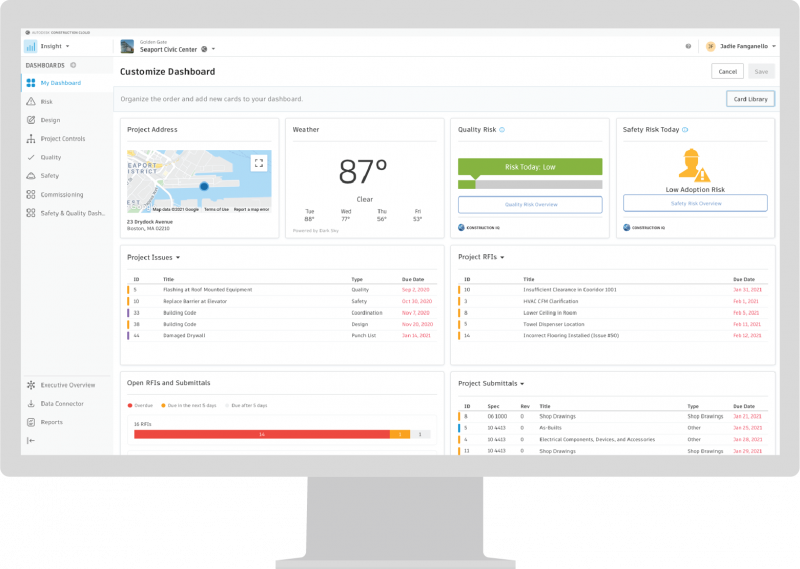
2. Reports
Reporting is a necessary but often time-consuming project activity. Within Insight, we aim to make reporting easier. By having a centralized place to create, schedule, and share reports, teams save a lot of time and always know where to find the most current information.
Within the Reports tool you will find a series of reporting options including Issue, RFI, and Submittal summary and detail reports. Reports are easily customizable and can be grouped by or filtered to fit your specific needs. Finally, these reports can be scheduled on a reoccurring basis and shared with other team members based on user, company, or role.
“The reporting and dashboarding features in Construction IQ provide clear and concise feedback on the various project critical data streams. This information enables our project management teams to make the right decisions more rapidly and effectively,” says Michael Murphy, Digital Construction Operations Manager at BAM Ireland. “With these features, we’re having less reactive conversations with more emphasis on KPIs that can drive continual improvement. The simple visualization of the challenge or the issue alone helps us bring that focus.”
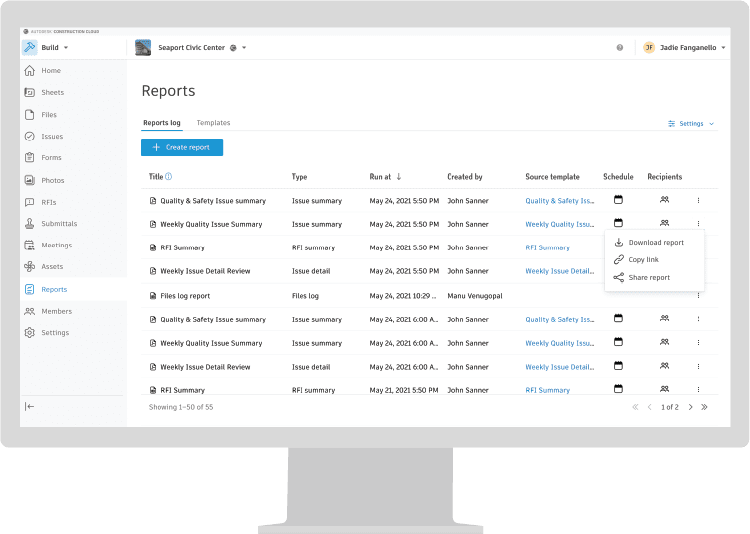
3. Data Connector
Through a single click, Data Connector allows teams to quickly extract project data from both the Autodesk Construction Cloud platform or BIM 360 for customized use in other robust business intelligence tools. You can also easily schedule extractions and sync them directly to Power BI through the Power BI Connector. And to make this a full circle connection, you can even use the Power BI partner card to then view those Power BI dashboards directly within an Insight dashboard and share it with the rest of the project team.
We also created easy to set up Power BI templates so that you can quickly start leveraging your data and customizing dashboards to see exactly what you want.
The Data Connector saves teams time and money by giving them a tool to extract data without needing expensive APIs or custom coding in addition to improving data visualizations to inform better business decisions.
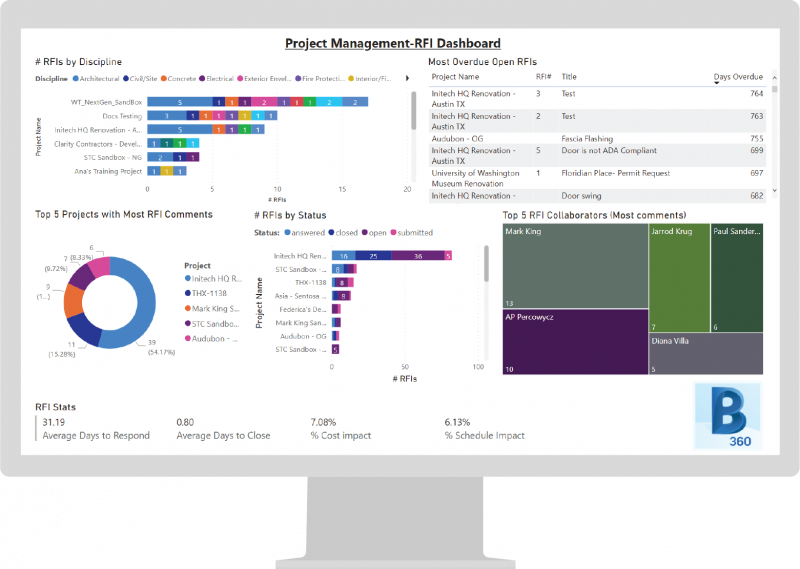
4. Construction IQ
Construction IQ is a machine learning based capability that delivers risk analysis of quality, safety, design, and project controls data from both Autodesk Construction Cloud platform and BIM 360 projects. Construction IQ moves beyond the traditional concept of static data and takes prediction to the next level with assistive, action-based intelligence. The capability allows users to:
- Better manage project risk and outcomes by identifying high risk issues that have the potential to impact cost, schedule, quality, and safety
- Evaluate subcontractor performance and predict potential risks on a day-to-day basis and for future projects
- Help project leaders understand high risk quality problems and actions to mitigate that risk
- Help design teams identify issues that are at higher risk to turn into costly RFIs downstream during construction
- Give project leaders visibility into RFI risk to prioritize and manage RFIs that could add significant cost and schedule impacts
- Help safety managers understand leading indicators to potential behavioral and environmental hazards and take proactive measure before incidents happen
- Help construction executives identify risks across projects and proactively improve project outcomes
Most importantly, you do not have to do any extra work to get the benefit of Construction IQ. All data captured during construction is continuously and automatically analyzed.
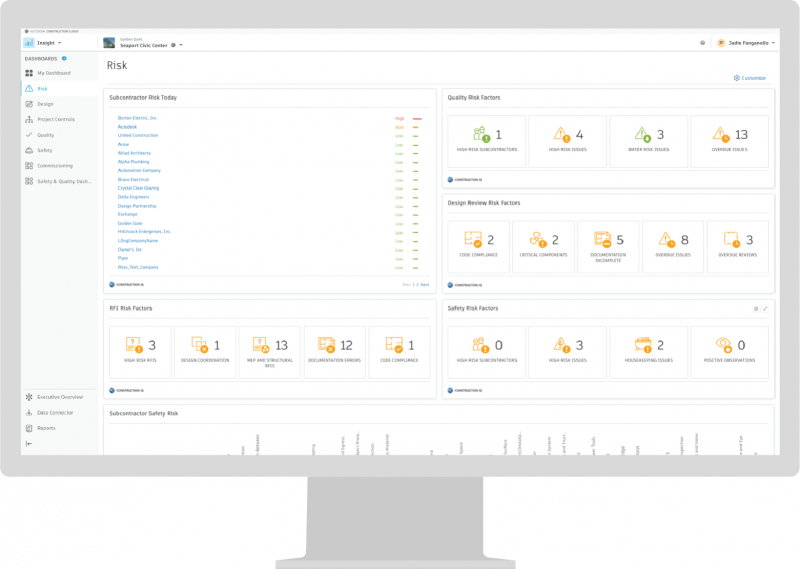
Power Project Success with Better Construction Data Analytics
Get more out of your project data with Insight for the Autodesk Construction Cloud platform and BIM 360. Learn more here.
The post How to Manage Project Risk with Construction Data Analytics appeared first on Digital Builder.
The True Cost of Not Having a Data Strategy

In any workplace, good decisions drive good outcomes. In construction, those outcomes can vary from staying on schedule to facing major time and cost over-runs.
But decision makers are now contending with more complex projects and shorter timelines than ever before.
In fact, four in five APAC construction professionals say schedule compression is fueling the need to make more rapid decisions, according to Autodesk Construction Cloud’s new Harnessing The Data Advantage In Construction report.
Autodesk partnered with FMI Global to survey more than 3,900 construction industry stakeholders, including more than 500 across Australia, New Zealand, Singapore, India, and Hong Kong, to understand how their approach to data was propelling them forward – or holding them back.
And the single biggest factor interfering with making good decisions? The lack of reliable data.
Data quantity
The research revealed vastly different approaches to data strategy, but what’s almost universal is the fact that more data is being generated and collected than ever before. In fact, most project managers and field supervisors report spending two to three days a week collecting and managing the ever-increasing torrents of data.
A big factor in this workload is the multiple channels from which data must be collected, and the numerous formats it arrives in. As one subcontractor told us, “The usual way in which most construction companies operate is a lot of decentralised information.
“We create 2D designs, spreadsheets, PDFs and a whole range of different file types and formats. This is very hard to manage.”
Data quality
Not only are many streams of data unwieldy – they can also be tainted.
For the average construction firm, almost 40% of the data they are collecting is bad – inaccurate, incomplete, inconsistent or untimely.
For data to produce valuable insights and drive better project outcomes, it needs to be readily:
- Accessible
- Consumable
- Understandable
Worryingly, just one in eight construction professionals believe that most of their data meets this definition. This doesn’t just undermine confidence in data-driven decision-making; it undermines projects too.
Industry data indicates that for every $1 billion of revenue earned by a contractor, the total cost of poor decisions driven by bad data could be as high as $165 million. In fact, it is estimated that bad data is responsible for 14% of all construction rework.
That means bad data costs the construction industry an estimated A$2.49 trillion in 2020. And that’s before we count:
- the environmental cost, with global construction waste reaching 2.2 billion tons by 2025, and
- the reputational cost, including 77% of megaprojects being delivered at least 40% late.
Difficulties using data
Despite the vast increases in data flows, barely one in 10 construction professionals report always incorporating project data into their decision making. Most do it sometimes, at best.
These concerns over data quality are why the companies that are reporting getting the most out of their data have formal plans in place to ensure the quality of their data.
“We have invested a lot of time and money ensuring the integrity of our data. Otherwise, it will all be a terrible waste,” one told us.
Another contractor explained, “We want the data to work for us and not against us. If you have bad data, the results will be bad, no matter how good the process is.”
Among the chief challenges faced in using the data being collected are:
- combining data from two different sources
- grappling with missing information
- difficulties in accessing data, either because of its structure or because other parties are unwilling to share.
Overcoming this requires both process and people solutions.
On the process side, for instance, replacing non-collaborative digital channels such as email with cloud-based, construction specific technology can ensure data is collected accurately and easily accessible.
Underpinning all of this is a firmly mapped out data strategy. Such a strategy must cover which data is the most valuable to a given team, and how it can be made reliable and accessible.
Having this not only helps you ensure your processes and tools are fit for purpose – it also helps bring the people you need up to speed.
A subcontractor in the mechanical, electrical and plumbing sector told us, ”Everything is centred on our information being iterative and creating bidirectional workflows with BIM software to drive commissioning activities out on-site.
“That means that we can actually collect data from the field and format it back into the model. We’re getting consistency through construction documentation – and consistency breeds quality.”
Data-driven decision making
Our research clearly shows the impact of trying to make decisions with bad data – the average company reports that it results in poor decisions 38% of the time.
On the other hand, those companies that have nailed their data strategy say it is driving fewer budget overruns, fewer missed schedules and fewer safety incidents.
By managing data effectively from collection to access, these are the companies unlocking its value and moving to the next level, where nothing is left to chance.
An integrated digital approach allows them to see all of the dependencies on a construction site and review the project schedule for potential risks. They can see how a change order might affect the project’s critical path, and re-prioritize accordingly.
Despite this, one in three APAC construction firms without a data strategy say the cost and resourcing required for a data strategy is holding them back.
It’s a bit like trying to save money by skimping on maintenance – any savings you make will be wiped out when something inevitably goes wrong.
Learn more about how Asia-Pacific construction firms are using data to build better in the Autodesk/FMI Harnessing The Data Advantage In Construction report.
DOWNLOAD NOW
The post The True Cost of Not Having a Data Strategy appeared first on Digital Builder.
Did you miss our previous article…
https://www.arizonasolarsociety.com/?p=1234
Technology Increases Productivity by a Quarter on UK Rail Projects
Did you know that technology is increasingly playing an important role in the rail industry, helping to achieve safety milestones, meet passenger demand and expectations as well as reducing the impact on the environment? For the rail industry, an exciting era of innovation is underway supporting train operating companies and rail asset owners to analyse, monitor and track data collected and captured to enhance safety, reliability and service to customers.
For BAM Nuttall, technology has played an important role in the delivery of two major rail projects from 2017, with the ambition to improve rail capacity in the North West of England. One project for Merseytravel involved preparing the rail infrastructure for a new fleet of Stadler trains. This £18m Merseytravel Depot Construction Contract (DCC) project included upgrading the existing Train Maintenance Depot (TMD) at Kirkdale, with stabling facilities, maintenance sheds, offices and a training simulator.
Running concurrently, the Northern Train Lengthening programme was a £3.9m project for Network Rail to extend all the platforms at five stations between Streethouse (Featherstone) and Knottingley in Yorkshire. The new platforms would accommodate the three car trains used in the new fleet, delivering a 50% increase in capacity. The complex, multidisciplinary projects incorporated rail, civil engineering, mechanical and electrical specialisms.
Safety is a key aspect to any rail project due to the complexity of the structures, the incredible attention-to-detail and meticulous planning needed to successfully deliver works around an operational train line. For BAM Nuttall, these projects were no different, and data is a key link to delivering these two projects safely, efficiently and on time. The team had to think outside the box to manage the projects’ health, safety and quality key performance objectives, and for Construction Project Manager Raymond Castelyn, it wasn’t workable to rely on paper-based processes.
“At the beginning of the project, the paper-based document management was a nightmare,” recalls Raymond. “The site was too large to be carrying around big drawings with you – and we had 150 drawings that were being regularly updated. Identifying locations could be a challenge, as the appearance of the site before and after the project was as different as night and day.”
Identifying efficiency gains to improve project delivery
For the team working on the project, manual processes also slowed down the project’s progress. Photos taken of the site had to be downloaded from devices, saved in a folder and then relabelled with their location, to make them searchable. Manual methods of working were also used to identify and report both health & safety and quality issues, through track sheets. “The documents would be printed and then filled out manually, normally when people got back to the office – so it was hard to be sure they were always accurate,” recalls Raymond.
The team was not only relying on manual processes for their operational activity but also for performance tracking, which made it difficult to quickly identify trends and patterns that could precede undesirable outcomes. “With the paper-based processes, we had no traceability, mobility or transparency – and it wasn’t sustainable.” So, Raymond decided to find and adopt a solution that would improve upon traditional techniques for gathering, analysing and reporting the site data.
A connected construction journey begins with a single step
BIM 360, an Autodesk Construction Cloud product, is a unified platform that connects project teams and data in real-time, from design through construction. BAM Nuttall had been using BIM 360 on a selection of projects since 2012 so Raymond and the team decided to implement it into these significant rail projects. They were equipped with five iPads to use on-site and from January 2018 and the project moved to an entirely digital way of working using BIM 360.
From photo tracking of activity on site to producing a 3D model of the project, the technology has supported BAM Nuttall to work in a more connected way, helping the team to navigate the complexities of these projects and ultimately make better decisions. Being able to access drawings and models allowed the team to coordinate better: “We had a 3D model of the 1,040 individual buried services revealed by the ground penetrating survey. If I went on-site and someone asked me, ‘Where’s that water main?’ I could look it up on the iPad and say with complete confidence, ‘It’s two meters from that manhole.’ That was hugely important,” says Raymond.
Accelerating accountability and transparency across the supply chain
The two projects benefitted from improved levels of accountability. Being able to track the cost of each Non Conformance Report (NCR) and identify challenges with any subcontractors or elements supported this. The team generated reports using BIM 360 to send to each subcontractor on a weekly basis and monthly reports were also shared with the client and the wider BAM Nuttall team. This helped improve visibility and communication across all contributors.
On both projects, efficiencies were improved significantly using BIM 360, according to data that the project team collected. On the Merseytravel DCC, the project saw savings of 13.4 hours in a 50-hour week per person when averaged across the team, resulting in a 27% increase in efficiency. The results on the smaller Northern Train Lengthening programme were consistent, with 16.2 hours saved per person per week, equivalent to a 32% increase in efficiency. Team members noted in a survey that the impact on their working day was significant: “Huge time and cost savings can be made on a project by using BIM 360 to manage the site.”
Insights today to be used tomorrow
Using BIM 360 to capture data on site helped the team handover the project to their client, supporting them with better insights on the asset. The platform opened up significant possibilities for data analytics, as due to the rich data export function, the information could be visualised in PowerBI. Raymond asserts: “Having all the data in one place means you can start doing the smart stuff. You can track close calls and issues or pick up problems in particular areas like concrete. Traditionally it would be really complex to pull that information from Excel sheets, but with BIM 360 the data is exported with the click of a button. Data is what it will all be about going forward, and with BIM 360 you get a solid foundation in place.”
The Merseytravel Depot Construction project was the first time that a 3D model had been linked into BIM 360 in the rail division. And, following the success of the project, in 2019, BAM Nuttall have rolled out BIM 360 across most rail projects with similar successes achieved.
The post Technology Increases Productivity by a Quarter on UK Rail Projects appeared first on Digital Builder.
A Connected BIM Approach Helping to Achieve High Levels of Productivity for the Anel Group
The name behind countless successful electrical and mechanical infrastructure designs of building projects in Turkey and across the globe, Anel Group stands out with its expertise in BIM (Building Information Modeling). The organisation uses Autodesk Architecture, Engineering & Construction (AEC) collection including the Autodesk’s Construction Cloud platform. These include an integrated BIM toolkit, BIM 360 Field and Autodesk BIM Collaborate Pro cloud services, with the aim to support Anel achieving their global goals that require high efficiency, remote collaboration and coordination capabilities.
Passion for implementing complex projects with an environmental approach
Anel Group’s journey began with the establishment of Anel Elektrik in 1986 by Electrical Engineer Rıdvan Çelikel. Established 35 years ago, the company is transforming into a 2,000 people strong group of companies that operates in the fields of panel production, electrical and electronic systems of ships, renewable energy, recycling and operational maintenance, as well as electrical and mechanical contracting.
Since its inception, the company has successfully delivered more than 200 projects spanning a total area of over 13 million square meters in 14 countries across three continents. In addition to its ongoing MEP operations in Qatar, the United Arab Emirates (Abu Dhabi and Dubai), the UK, the Netherlands, Turkey and Azerbaijan, the company is also engaged in operational maintenance services, low voltage panel production, electric and electronic systems of ships (defence industry) and recycling.
Anel Group Tender and Procurement Director K. Serkan Kılıç, who is also an Electrical Engineer, said, “We are a team striving to deliver solutions for the world we dream of” and added: “A single structure has the power to make a big difference in the world: A bridge connecting two continents, an airport that makes the world feel a lot smaller than it is, a hospital that saves lives… We can list a myriad of examples from world history.”
Emphasising that the success of a building project depends on the ability of combining engineering skills from different disciplines in harmony, Kılıç said, “We leverage our engineering skills in designing the electrical and mechanical aspects of a building. We are passionate about realizing large-scale and complex projects in different regions of the world. With a view to contributing to an environmentally, socially and economically sustainable world, we combine our engineering and technology capabilities with our strategic skills and take innovative initiatives.”
“We leverage our engineering power to create solutions and aim to use cutting-edge technologies that we could benefit from the most. Especially in a two-year retrospect, Autodesk AEC Collection and Autodesk Construction Cloud’s solutions have helped us immensely as we seized opportunities around the globe.” —Serkan Kılıç, Tender and Purchasing Director, Anel Group
Engineering strength powered by technology

Autodesk’s AEC Collection as well as their Construction Cloud forms the technology backbone that supports Anel Group’s engineering strength and strategic capabilities. This solution package, which includes an integrated BIM toolkit and is designed for the building industry, has also played a pivotal role in Anel Group’s international expansion efforts since 2016.
Anel Group BIM Manager and Mechanical Engineer Ümit Balaban has led the establishment of the BIM infrastructure and the introduction of BIM processes across Anel Group. He said, “The BIM processes need continuous improving to keep up with the ever-evolving technologies and engineering industry.” He is responsible for managing the compliance of the projects undertaken by the company with the BIM processes and provides support to all BIM managers assigned to the projects. He is also the founder of the BIMgenius Community, a not-for-profit made up of professionals who have come together to collaborate to support the digitalization of the architecture, engineering and construction industries.
The Anel Group team can manage electrical and mechanical projects via the AEC Collection in alignment with BIM processes, starting from the tender phase, all the way to the design implementation and delivery phases via the Autodesk Construction Cloud. Anel Group, which started using BIM 360 Field, BIM 360 Docs and made it its primary application following the increasing need for working remotely due to the pandemic, leverages the advantages of savings and efficiency of cloud services in field monitoring and management, documentation management, remote collaboration and coordination activities.
Anel Group’s BIM Journey: Qatar Metro Red Line South Project
Pointing out that Anel Group had reached a significantly high level in terms of technology in the last five years, BIM Manager Ümit Balaban said, “The company’s progress in its ERP infrastructure, communication infrastructure and BIM infrastructure sets an example for digitalisation in its area of operation.”
Driven by global goals, Anel Group operates as an electrical and mechanical contracting company undertaking complex projects. Undertaking a BIM-managed metro project in Qatar in 2016, the company took action to create a structure that could support all projects under a BIM umbrella in the future. Senior management was aware of the importance of digitizing and implementing BIM processes in line with their goals.
“The approach we embraced to address this issue is a pioneering one within our area of operation,” said Ümit Balaban. “Our initial move was to create a BIM Commission that would include representatives from all departments. Thus, we were able to promote an awareness on BIM processes across the entire organization. At periodic meetings, we determined what we could improve in BIM processes and set our standards.”
“70% of the projects we take part in are managed with the BIM infrastructure and all of them are ongoing projects abroad. It was the efficiency boost and savings opportunities of Autodesk BIM Collaborate Pro and BIM 360 Docs that has enabled us to achieve this rate in the last two years.” —Ümit Balaban, BIM Manager/Mechanical Engineer, Anel Group
Ongoing progress with continuous improvements
The team responsible for the metro project in Qatar had BIM managers on board. Their feedback helped the commission further improve the processes.
Ümit Balaban said, “During the course of this project, we have developed solutions addressing several questions such as how to make cost estimates and measurements, how to transform existing legacy standards within models, how to align operation and maintenance activities with this new structure.”
In addition to the company that manages electrical and mechanical projects, Anel Doğa and Anel Marin are also Anel Group companies. Active since 2003, Anel Doğa was established as the first and only electronic waste recycling plant in Turkey. Anel Marin, on the other hand, has been providing a wide range of services to the shipbuilding industry, including concept and configuration design, equipment, project management and consultancy, manufacture of panels and control consoles, design and manufacture of special military systems, system testing and commissioning, maintenance-repair activities, since 2005. “The know-how and experience of these two companies enable us to broaden our horizon as well as improving our BIM processes,” added Ümit Balaban.
Piloting Autodesk BIM 360 Glue and BIM 360 Field for the metro project in Qatar
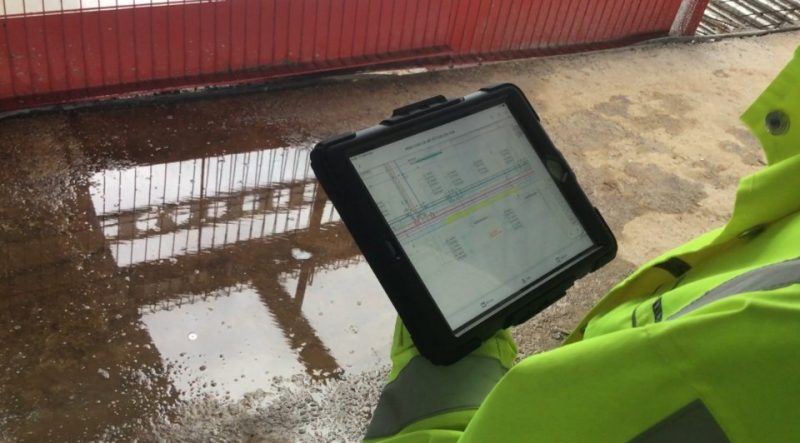
In addition to the numerous BIM-aligned projects that Anel Group has completed abroad, its ongoing projects include Amsterdam Schiphol Airport New Pier in the Netherlands, the University College London Hospital Proton Therapy Center in the UK, Abu Dhabi International Airport Terminal Building and Dubai – I (Bluewaters) Terminal Building in the UAE, Semaisma Road and Infrastructure Work in Qatar, Lusail Katara Hotel and Lusail Plaza Towers projects.
BIM managers supervise each project and receive support from the head office in Istanbul. Ümit Balaban stated, “During the pandemic, when we could not visit the project locations, we started to transform our head office in Istanbul into a main design office. We started using Autodesk Construction Cloud’s BIM 360 Docs solution in 2019, and it has become our primary platform following the pandemic.”
The metro project launched in Qatar was considered a pilot. First, two tablet computers were purchased. They tested ways through which they could communicate with the field via BIM 360 Field & Glue mobile apps using tablets, monitor man/hour, and devise quality control lists from a small office located at one of the emergency exits on the metro line. Balaban also added, “With a very modest investment, we accumulated valuable know-how and experience even during the pilot phase.”
Know-how and experience shift from being individual assets to being corporate value
“Our BIM approach and the use of Autodesk BIM Collaborate Pro enabled us to transform know-how and experience from being individual-centric to being corporate assets,” noted Balaban.
Now, it is possible to easily access to and align our activities with all BIM processes and standards thanks to the document management features on Autodesk BIM Collaborate Pro. Even if any BIM manager leaves a project, the successors are quickly onboarded to continue working with the same standards. The BIM platform offers a structure that allows corporate memory creation as well as know-how and experience retention.
Contribution of BIM expertise to global business opportunities
As a publicly traded company, Anel Group differentiates itself from its competitors with its transparent structure. BIM processes can help companies with transparent management to achieve significantly successful results. The fact that coding and drawing standards serving global efficiency, such as equipment order codes, have been established within Anel Group, can be cited among the outcomes of transitioning to BIM processes.
Ümit Balaban said, “This is a perpetual process that is an absolute necessity for development. If a project necessitates BIM by design and you do not have your own corporate structure to accommodate it, you can only achieve partial success and will have to deal with low efficiency. Our expertise in this field positions us well to be commissioned by major Turkish and foreign contractors that have a good command of BIM processes.
70% of the projects we take part in are managed with the BIM infrastructure and all of them are ongoing projects abroad. It was the efficiency boost and savings opportunities of Autodesk’s BIM Collaborate that has enabled us to achieve this rate in the last two years.”
Autodesk’s BIM Collaborate Pro for the future

Ümit Balaban said, “Autodesk BIM Collaborate Pro, which we have used since 2019, is our main application. Firstly, we used BIM 360 Build to track the progress of the field, then utilized the quality checklists. Afterwards, we switched to BIM Collaborate Pro to rid ourselves of the labor and cost burden of installing a Revit Server on-site. This move provided us with a great advantage in design budgets.”
Balaban also added, “This approach delivered significant benefits during the University College London Hospital Proton Therapy Centerproject in the UK. We ensured that the project was delivered with an asset model created,” and noted that the deliveries of the ongoing construction projects in Qatar would also be made with asset models.
Balaban said, “Thanks to the coding standards we introduced with BIM, we integrated this model, which was often overlooked by employers, leading to a costly outcome, into our processes. Seeing the cause-and-effect relationship in these projects first hand, we have achieved a highly significant level of company-wide adoption of the BIM processes.”
Productivity boost driven by collaboration and coordination
The document management features of Autodesk BIM 360 Docs further consolidates collaboration and coordination capabilities while also ensuring efficient use of teams.
Ümit Balaban said, “We used the Autodesk BIM Collaborate Pro approach in nearly all the stages of our airport project in the Netherlands. We use the Review Process feature of Autodesk BIM 360 Docs very effectively. With the Review & Approval feature, you can track all the steps and tasks of a project on an individual basis. It ensures transparency in every step. Engineers, who used to only look at the survey of the sheets, have to look more carefully at the label within the sheets and the dimensions of the channels and really focus. User experience is really evolving. It is safe to say that this a true evolutionary process for the construction industry.”
With the integration of Autodesk BIM Collaborate Pro into the business intelligence platform PowerBI, it is also possible to turn the results into charts and present them to the top management.
Saving time, paper and labour costs
Anel Group ensured that sheet revision notes were recorded on Autodesk BIM Collaborate Pro. Draftspeople began to read those notes through Autodesk BIM Collaborate Pro and apply them. With the possibility to track the steps, which could not be monitored with the previous method, unnecessary repetitive work, unmeasurable loss of time, and the need for sheet printouts have been eliminated.
The field management features of BIM 360 Build have also delivered significant benefits. Ümit Balaban describes them with an example: “Depending on project locations, some construction projects may be halted due to weather conditions or the employer may ask us to proceed regardless of the conditions. In such cases, you or your subcontractor may need to charge a fee for extra costs. “
Since everything is recorded on BIM 360 Build, you can easily monitor whether the employer received a revised quote and whether the extra cost has actually been incurred. The result can be reached by looking at the number of workers in the field, weather conditions and other data. Being able to record the process in its entirety ensures transparency.”
This structure also allows for an accurate evaluation of the subcontractors. The company name, number of workers, total time and progress are all recorded with the document management feature of BIM 360 Field. With the integration of BIM 360 Field Management into the business intelligence platform PowerBI, it is also possible to turn the results into charts and present them to the top management. These charts also show which subcontractor would be the best to work with in the next stage.
Labour savings in the Quality Control process
Using BIM 360 Field Management also offers benefits for the quality control process. With the legacy methods, it would take 80-100 minutes to prepare an average quality checklist. BIM 360 Field Management saved us close to 50 minutes in each checklist. We owe this time saved to the fact that BIM 360 Field Management allows you to instantly add the relevant document while devising the checklist as the documents are also on the same platform. Similarly, it is possible to link the list to documents or to put dots on it and link them to the equipment.
Ümit Balaban said, “Considering that a project is completed with 2,000 to 5,000 checklists, we can achieve a significant level of man/hour savings. One of our current projects was completed with 3000 checklists, saving us a total of 800 man/hours. This is just the tip of the iceberg as it has only been a few months since we started using the checklist function of BIM 360 Field Management. Once we start using the material approval checklists, we expect to see a further increase in our savings. Especially when you have operations abroad like we do, it is possible to get the return on your initial investment within a very reasonable time and manage more projects with the same teams.”
Accelerated improvement process with Forge and Dynamo
Ümit Balaban pointed out that there were many experts both within Anel Group and among Autodesk users who coded using Dynamo and that they were always on the lookout for codes that could be useful for them.
He said, “For instance, one of our BIM managers in Qatar wrote a code on Dynamo that allowed for the scaffolding system of a 40-meter tunnel to be automatically placed according to the data received. It was a code that helped us to significantly reduce the man/hours and to streamline our work.”
Stating that they also had an application which was written on Dynamo and which they used for cost estimation and quantity surveying, Balaban said, “In line with the volumes indicated in the planning, we wrote a code for the location of the objects that corresponded to those volumes, and we determined the costs and quantities based on this code. We have also started using Autodesk’s cloud-based development platform Forge. We are using Forge to ensure that the data extracted from BIM 360 Docs is well integrated into the applications on our platform called ‘Digital Anel’ and smoothly communicates with PowerBI.”
Anel Group Tender and Purchasing Director K. Serkan Kılıç said, “We leverage our engineering power to create solutions and aim to use cutting-edge technologies that we could benefit from the most. Autodesk has always been a trusted companion. Especially in a two-year retrospect, Autodesk AEC Collection, BIM 360 Docs, BIM 360 Field and Autodesk BIM Collaborate Pro cloud solutions have helped us immensely as we seized opportunities around the globe. These technologies provided us with the agility to quickly adapt to remote working conditions, enabling us to use our teams in the most effective way possible, boost our operational efficiency and drive our costs down.”
The post A Connected BIM Approach Helping to Achieve High Levels of Productivity for the Anel Group appeared first on Digital Builder.
Tête de la Course: How Digital Construction Can Grow Europe’s Cycling Infrastructure
Did you know you can cycle from Rotterdam in the Netherlands to the Shetland Isles off the tip of Scotland? Admittedly, there’s a ferry or two along the way. But the two locations are linked by the North Sea cycle route, a 7,050 km path across six countries. Cyclists get to enjoy 18 UNESCO sites, cliff top views and bustling cities – all on a single ambitious trail.
This is just one part of Europe’s incredible cycling infrastructure. Bring your bike to Holland and you can traverse 4,500 km of long-distance routes specifically for cycling holidays – or try the Elbe cycle route, spanning the incredible sandstone mountains in Switzerland and the beautiful city of Prague.
The popularity of cycling in Europe has increased significantly during the pandemic, with people taking to their bikes for commuting, fitness and relaxation. But the organisations that build and maintain cycling infrastructure have a key role to play in making this a sustained trend.
Here’s how the construction industry can help to create a bigger, safer cycling infrastructure across Europe.
Riding the post-lockdown cycling boom
Governments have long promoted the benefits of cycling: it reduces carbon emissions, lowers air pollution, eases the pressure on public transport and improves physical and mental health. But it was the events of 2020 – including concerns about social distancing and limited train services – that prompted a massive rise in cycling across Europe.
In June, Paris saw its monthly ridership grow by 120% compared to the previous year. Even wintry weather didn’t deter Berlin’s cyclists, with rates in December up by 23% over 2019. Meanwhile in the UK, sales of bicycles and accessories grew by 45% in 2020.
Countries have been eager to take advantage of this interest by introducing a range of measures to promote cycling and help citizens shift their extra lockdown kilos. The UK government introduced pop up bike lanes and corridors during the pandemic to make it easier to get around. Italy’s Covid-19 recovery package includes a 70% subsidy for bike purchases.
But another crucial piece of the puzzle in every country will be creating a safe and appealing cycling infrastructure to keep new riders on the road – and this is where digital construction can help.
Three ways to keep your project in gear with digital tools
1. Use modelling to keep cyclists safe
The right road design can help keep cyclists safe. In fact, research shows that prioritising cyclists in road layouts can result in fewer fatalities for cyclists, motorists and pedestrians too. This means incorporating features like dedicated bike lanes, which can lead to 90% fewer injuries per mile; protected intersections, that physically separate bikes and other traffic; and bus stops, which reduce the risk of injury to cyclists
Digital tools like mobility simulators can help planners to assess how the route would work in real life. With multimodal analysis, it’s possible to simulate how traffic, pedestrians and cyclists would interact with each other in a given design – and optimise for effectiveness, cost and safety. As well as saving traffic analysts time, this helps to ensure that the planned infrastructure will meet the needs of road users for years to come.
2. Bring everyone along for the ride with BIM
Successfully planning cycling infrastructure often involves many stakeholders – and keeping everyone fully up to date can be a significant undertaking. Using BIM models and digital collaboration platforms makes it much easier to share designs for input and approval. With real-time visibility of feedback and suggestions, these tools can speed up the whole process.
Importantly, these models can also be used to share plans with the public during planning and construction. 3D tools can help people to visualise the finished design and likely impact on the area. Local communities can also get the opportunity to offer useful insights on issues like the location of end of trip facilities and bike storage – factors which can have a significant influence on cycling uptake. This engagement can not only raise awareness of planned infrastructure, but ultimately encourage people to take to their bikes when the new routes open.
3. Ensure high quality construction with digital platforms
The road surface is hugely important to the comfort and safety of cyclists. Asphalt concrete’s low friction and smooth surface make it the surface of choice in Denmark, for example; by contrast, gravel and paving slabs can become uneven and potentially dangerous. The quality of the surface construction is critical. Bumps and dents in the road can not only ruin the experience, but contribute to falls and accidents.
Digital construction platforms like Autodesk Build can ensure that everyone on-site has the information needed to build right first time, while quality control tools ensure that any issues are addressed before routes open. This helps to ensure a top-quality cycling route, that will keep cyclists safe for years to come.
Keep riding on
The increase in cycling is one of the few positives to emerge from the pandemic. But to encourage people to stay on their bikes in the years ahead, it will be important to keep improving and constructing new routes to make cycling convenient, safe and enjoyable.
Technology can support everyone involved in delivering cycling infrastructure: from the owners looking to deliver the best value for the public through to the subcontractors aiming to finish on time, on budget and to the highest quality possible. Using digital tools, we can help everyone to get the most out of these infrastructure investments – and enjoy more time on two wheels.
Read how digital modelling can support safer post-Covid commuting.
Or if you’re a cycling fan, check out how the Tour de France and other sporting icons adapted to Covid-19.
The post Tête de la Course: How Digital Construction Can Grow Europe’s Cycling Infrastructure appeared first on Digital Builder.
Digital Builder Ep 15: Why Global Data Standards are the Future of Collaboration
As the volume of project data continues to grow, and global collaboration in the AEC industry becomes increasingly common, it’s more important than ever that the processes we have are scalable and sustainable.
Collaboration can be a powerful thing, but it produces far more successful outcomes when team members operate under agreed-upon standards. To put it another way, construction professionals need to speak the same language.
On Episode 15 of Digital Builder, Marek Suchocki, Infrastructure Industry Engagement Lead at Autodesk, and Frederico Ramos, Principal at Aedas join us to discuss the importance of global data standards in the AEC industry. Other topics we chat about include:
- What exactly is ISO 19650?
- How data standards are created and implemented
- The challenge when teams leverage conflicting data standards
- Tips for implementation when scaling into new regions
- The future of common data standards
“Because BIM is fundamentally about collaboration and transparency, that is radically enhanced with common standards.” — Frederico Ramos
New Episodes Every Two Weeks
Digital Builder is hosted by me, Eric Thomas. Remember, new episodes of Digital Builder go live every two weeks. You can hear more episodes like this one by subscribing to Digital Builder on Apple Podcasts, Spotify, Stitcher, Google Podcasts, or wherever you listen to podcasts. You can also subscribe to our email list with the form below so you’re the first to hear when new episodes are released:
Here’s a recap of the key takeaways from the episode.
Why are Global Data Standards Important?
Global data standards define the processes for collaboration and information management by setting clear guidelines throughout the entire lifecycle of a construction project.
Data standards are important to have in the AEC industry because they enable team members to collaborate effectively. As Frederico puts it, “standards are derived to allow us to easily communicate and interface with each other.”
When team members are able to stay on the same page, construction firms can improve efficiency and minimize miscommunication — ultimately reducing risk and improving outcomes.
That said, it’s important to remember that data standards aren’t created and used in a vacuum.
According to Marek, “Standards are not developed because one person thought them a good thing, they are really a community initiative.”
In the UK, for example, Marek says that they have a body called British Standards that organizes the creation of new standards. “They use the community of experts to define what constitutes good practice,” he adds.
What is ISO 19650?
ISO 19650 is a series of quality standards concerning the organization and digitization of information about buildings and civil engineering works, including building information modelling (BIM). Essentially, it allows people using BIM to smoothly communicate with each other.
According to Marek, this set of standards came about as a result of a joint effort between different industry players. “The international community came together, negotiated their own terminologies, negotiated around all the details of the standard and created what we call ISO 19650 today as a family of standards.”
ISO 19650 has six components:
- Concepts and principles
- Delivery of the asset
- Operational phase of the asset
- Information exchange
- Security of information
- Health and safety
The fourth and sixth components are currently in draft and their development is a reflection of ISO 19650’s growing popularity. “It’s really a good reflection that they’ve proven so popular that people are recognizing that if we can deploy these information management principles and procedures in different sub areas of our industry, that they are working,” says Marek.
Frederico weighs in and talks about why AEC pros should seriously consider using a global standard like ISO 19650.
“I personally believe that even if you don’t want to use a standard, you already are using a standard — your own. So it makes all the sense that if you are going to adopt the standard just adopt the one that is going to be widely used in the world anyway. At least that will facilitate the way that you communicate with others.”
He continues, “BIM is fundamentally about collaboration and transparency, and that will be radically enhanced with common standards.”
Benefits of Adopting Global Data Standards
Adopting global data standards can make teams’ lives easier and improve operations in a number of ways.
For starters, when teams are following global data standards, they can see to it that the nomenclature of data files are consistent, thus making them easier to share with other organizations.
As Frederico points out, having agreed-upon standards across sectors and regions makes collaboration much more seamless.
“We can always argue that a good BIM execution plan will do the same, but it will not give you the universality of topics that ISO naming nomenclature will adopt.”
He adds that with the right standards, team members won’t have to come up with definitions because ISO already has those definitions.
“You just say, ‘Are we adopting the ISO 19650 definitions? Yes. So we have it.’ We all know what we’re talking about when we say BIM or when we say EIR.”
Having those standards ironed out from the get-go reduces the time you have to spend finding consensus on definitions and parameters. You and other stakeholders can move forward quickly and devote that time to more important things.
This, in turn, allows you to optimize your operations, which leads to cost savings, enhanced safety on work sites, improved sustainability practices, and increased customer satisfaction.
And these are just some of the immediate and obvious benefits. Adopting ISO standards can also pave the way for a better future for your organization and the industry.
“The fact that we have a standard that facilitates the way that we can collect data and structure data across the industry will make it much easier to be able to respond to the future needs of our industry,” remarks Frederico.
“A lot of people are talking about ISO because of what we need today. I tend to see it as a unified playing field in terms of data structure. It will, in the years to come, give us the base of data collection and database approaches that we’re going to develop in the future.”
Implementation: Where Do You Start?
Adopting global data standards — especially when expanding into new regions — can feel like a massive undertaking. The key to moving forward effectively is to just start.
You don’t have to revamp your entire process. Begin by narrowing down the specific areas or points you want to focus on, and go from there. As Marek puts it, “this isn’t about an all or nothing scenario. Go and fix the bits and the priority parts.”
Depending on your organization, one priority can be error- or waste-prone areas, where your costs are consistently high. Adopting global standards in these areas can improve efficiency and communication, generating a stronger ROI.
Determining the right priorities allows you to get “the biggest bang for your buck,” says Marek. “That’s because if you fix those things, you can then incrementally tackle all the others.”
He adds, “You won’t get the good data because you try to do everything. You should do it piecemeal and tackle the most significantly beneficial areas — whether that’s mitigating traditional issues or adding value.”
This piecemeal approach also applies to the manner in which you adopt data standards. In the case of ISO 19650, you don’t necessarily have to implement all of its components at once.
“This isn’t a ‘Thou shalt’ or ‘10 commandments’ type thing,” says Marek.
“This is a ‘Pick it up, use it, use it to the most appropriate way’ type of thing. If your community is not ready, don’t enforce it, just put in the good bits of it that they can adopt. Do the simple bits right and the extra bells and whistles will follow.”
The Future of Data Standards
Will we ever live in a world where common data standards are accepted globally?
That depends on who you ask. According to Frederico, there is a potential to adopt a truly global standard, but whether or not everyone gets on board is a different question. He says that as governments start to have more constraints to their budgets, people will be more inclined to have global standards.
Frederico also brings up the role of new technologies and their potential to drive the adoption of global standards. “As we move to a higher involvement…with AI, machine learning, and robotics, in all the lifecycle of the assets, you really need that data standard that will facilitate everything.”
Marek sees things differently and doesn’t think that the industry will have a common data standard as such. “What we will do is narrow them down. The rubbish ones will get thrown away,” he says.
Marek also predicts that the industry will transition to an “object-based way of work” that makes use of retrieval technology and machine learning. So, rather than trying to get everyone to speak the same language, collaborators can use technology to essentially translate certain terms.
“The Google analogy is really strong for me. I’m not going to force people to speak my language, but what I can do is interpret it,” he says.
“Is an object an elevator? Is it a lift? Is it a vertical transportation system? Are we talking about the same asset here? Let the search engine technology — whatever that might be — tell us if we’re actually talking about the same asset.”
Catch the Full Episode of Digital Builder
If you thought this was interesting, be sure to listen to the full conversation by downloading the latest episode of the Digital Builder podcast. Frederico and Marek dive deeper into ISO 19650 and share even more insights to help you adopt global data standards in your organization.
- Apple Podcasts
- Spotify
- Stitcher
- Google Podcasts
- or wherever you listen to podcasts
The post Digital Builder Ep 15: Why Global Data Standards are the Future of Collaboration appeared first on Digital Builder.
Did you miss our previous article…
https://www.arizonasolarsociety.com/?p=1211
3 Avoidable Headaches for Construction Project Managers [Webinar]
Relieve these common GC headaches by getting project teams on the same page.
Being a general contractor (GC) isn’t easy. Your construction project management skills are constantly put to the test. You’re at the center of a network of stakeholders who rely on your coordination alongside thousands—or even millions—of dollars to build the structures and infrastructure that help everyone else live their lives. And you have to do all that within a contracted amount of time with razor-thin profit margins.
With a role this demanding that evolves in complexity every year, it’s no wonder that processes that have worked well in the past are now routine headaches that every GC in the industry runs into. Some of the top problems GCs face are three documentation processes that, while important for communication and liability, take time away from actually building.
1. Creating the submittal log
The submittal log, in short, is a list of all documents that the contractor is required to provide to the design team to ensure that the project is following the spec book. Historically, the process has been to have a project engineer (PE), typically the newest builder, flip through the laid-out specs page-by-page and copy each submittal requirement into a spreadsheet. The project team can then track that submittal log throughout the rest of the project. This not only takes days or weeks for the PE to complete, but human error often results in oversights of important submittals that aren’t included in the log. When PE’s fail to record necessary requirements, they’re unlikely to do them. This puts GC’s in breach of contract, which can lead to costly rework, lawsuits, late delivery, or all three.
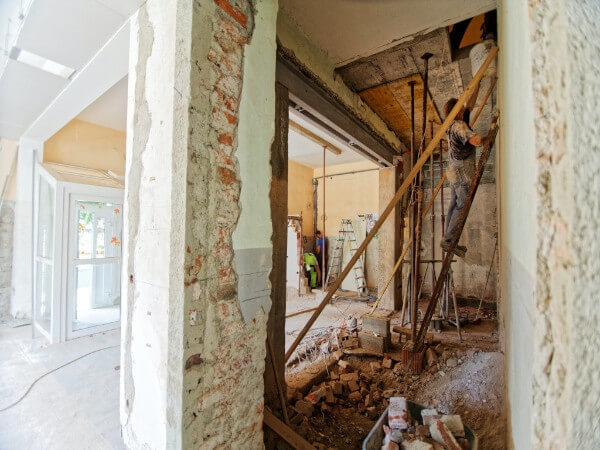
The modernized process that the industry is adopting is to use automated software like Pype AutoSpecs for initial submittal log drafting to save time, standardize processes, and mitigate risk. AutoSpecs scans spec books using a patented algorithm designed to identify all submittal requirements, QA/QC requirements, closeout requirements, mock-ups, product data, and a lot more. Project teams can quickly compare previous versions of the specs to the most recently issued version and review all changes, clearly identifying extraneous and redundant requirements. Top GCs are even using AutoSpecs’ built-in filters to review the log and assign custom sections of it to their trades.
Want to learn more about how AutoSpecs’ automation can save you time, standardize your processes, and mitigate risk across your projects? Join our webinar on November 16th to see it in action.
Register NOW
2. Maintaining a single source of truth
In an industry as iterative and paper-trail-y as construction, there is inevitably going to be a lot of contractually-obligated paperwork needing to be tracked. Between RFIs, contract documents, progress reports, as-builts, specs, plans, and hundreds more document types that can each contain hundreds of pages, it’s a lot for any project team to keep track of. And when contract compliance relies on following only the most recent documents like plans, specs, change orders, addendums, etc., making sure everyone is on the same page—literally and figuratively—can be the difference between a payday and bankruptcy for a GC.
Making sure everyone is on the same page—literally and figuratively—can be the difference between a payday and bankruptcy for a GC.
Most project management software solves for this to some degree, but only Autodesk Build allows access to these documents throughout the entire project lifecycle. Data created in design phase programs such as Navisworks and Revit is stored in the same common data environment (CDE) that the rest of Autodesk Construction Cloud uses, meaning that Build—and any other ACC software—can access this data at any time without having to push it back and forth between different modules.
All project data is stored in this CDE so that GC teams using Build always have access to the latest, most up-to-date documents to work with. This allows them to do their jobs without having to worry about a new version being published that they weren’t aware of. Autodesk Build maintains the single source of truth for GC teams, regardless of where the project is in the lifecycle. Watch the recorded webinar here.
Watch NOW
3. The turnover package
It’s a frustrating truth that even if the first 95% of a project goes perfectly, a fumbled turnover experience can leave enough of a bad taste in a client’s mouth that they’ll look elsewhere for a GC on their next project. Why is project turnover messy? Many GCs shift project teams to new projects out of necessity as their current project enters the closeout phase. That leaves the initial project with fewer people that need to shoulder extra responsibility in order to meet their closeout deadline. As a result, the tedious process of contacting subcontractors to request closeout documents and then getting them reviewed often falls to the wayside to make time for more immediate tasks on the new project. That is, until the turnover package becomes an immediate task itself.
Successful GCs use software like Pype Closeout to automate their closeout document collection process.
Successful GCs use software like Pype Closeout to automate their closeout document collection process. As soon as they have IFC specs, teams can start early by letting Pype Closeout automatically extract closeout requirements from those specs. As the project progresses, Closeout sends customized emails to trade partners as their scope of work gets completed in order to collect documents over time toward substantial completion.
Not only does Closeout take over a time-consuming task when there’s a myriad of other tasks for project teams to complete, but the end result for the operations team is a manual that can be stored in the cloud—and thus much harder to misplace. To everyone’s benefit, the cloud-based turnover package includes an internally linked table of contents that can be used to instantly jump directly to the documents needed in the moment. This leaves a much better impression on the client, and because GC teams could devote that time to other closeout tasks—like the punch list—they provide a better deliverable overall. Watch the recorded webinar here.
Watch NOW
Work smarter, not harder
General contractors are responsible for the smooth construction of contracted projects, which means any mistakes, delays, or cost overruns can easily land at their feet and threaten their cash flow. The processes to take on those challenges are constantly evolving as the industry evolves. Forward-thinking GCs are already adopting the technologies they need to stay competitive and not continually fall into these traps. With software like AutoSpecs, Autodesk Build, and Pype Closeout, GCs can give themselves that much more of an edge in an increasingly competitive market.
If you’d like a demo of Pype, please contact us. We’d love to show you how it improves the way you work.
The post 3 Avoidable Headaches for Construction Project Managers [Webinar] appeared first on Digital Builder.